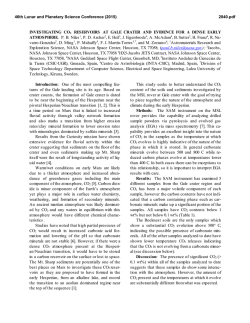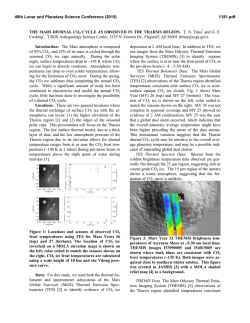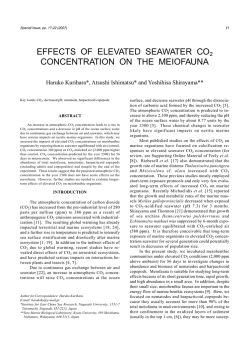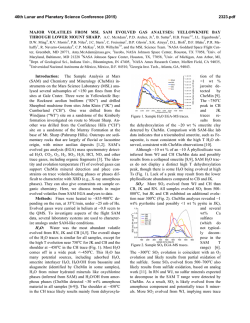
Genotypic Variation of Cut Chrysanthemum Response to High CO2
Genotypic Variation of Cut Chrysanthemum Response to High CO2 Concentration: Growth, Time to Flowering and Visual Quality D. Fanourakis1,2,a, E. Heuvelink1, R. Maaswinkel2 and S.M.P. Carvalho2,3 1 Wageningen University, Horticultural Supply Chains group, Marijkeweg 22, 6709 PG, Wageningen, The Netherlands 2 Wageningen UR Greenhouse Horticulture, Postbus 20, 2665 ZG Bleiswijk, The Netherlands 3 Portuguese Catholic University, College of Biotechnology, Rua Dr. António Bernardino de Almeida, 4200-072 Porto, Portugal Keywords: carbon dioxide, Chrysanthemum morifolium, closed greenhouse, cultivars, flower buds Abstract In this study sixteen cut chrysanthemum cultivars were used to evaluate the effects of high CO2 concentration (1500 µmol mol-1) on growth, time to flowering and visual quality as compared to the concentration used in commercial greenhouses (600 µmol mol-1). CO2 enrichment increased light use efficiency (11-41%) and total plant dry mass (TDM) (5-40%) in a cultivar dependent manner. This TDM increase was a result of: (i) higher relative growth rate during the long day period (i.e., 0 to 2 weeks; LD); and (ii) higher absolute growth rate both during the period between 2 to 6 weeks (SD1), and 6 weeks to final harvest (SD2). Cultivar differences in TDM at flowering between the two CO2 concentrations could be explained by differences in growth rate during the LD and SD2 periods. Furthermore, growing at high CO2 regime enhanced the number of flowers and flower buds per plant (NoF, 4-48%). Interestingly, the cultivars that showed the highest percentage of TDM increase, with CO2 enrichment, were not the ones that had the highest increase in the percentage of NoF. In contrast, high CO2 concentration had only a minor or no effect on the number of internodes on the main stem and on the reaction time in all the cultivars examined. From this research it is concluded that there is a large variation in the response of cut chrysanthemum cultivars to CO2 enrichment, in terms of TDM and NoF, which gives possibilities for breeding. INTRODUCTION The development of closed greenhouses (closed ventilation windows) is one of the major innovations in Dutch horticulture in the last years (Gelder et al., 2005). This new greenhouse concept is described in Opdam et al. (2005) and leads to a strong decrease in the energy and water consumption, a reduction in chemical crop protection as well as a yield increase, mainly because of the continuously high CO2 concentration (Heuvelink et al., 2008). To assure the return of the investment and high profitability in such a production system the selection of efficient cultivars, namely in their responsiveness to CO2 enrichment, is of utmost importance. However, besides vegetable crops (tomato, Gelder et al., 2005; cucumber, Luomala et al., 2008) there is no experience of growing ornamentals in such a system and the only comparable situation is to grow plants in climate chambers. Therefore, the impact of the new climate (i.e., high CO2 concentration and high light level) on plant growth and development is not yet fully understood. In chrysanthemum most studies on the effect of CO2 concentration have been focused on one cultivar. To the best of our knowledge only one in-depth systematic comparison between three cultivars (‘Refour’, ‘Dark Flamengo’ and ‘Cassa’) was performed, where an interaction between cultivar and CO2 concentration in biomass production, stem length and number of flowers was observed, when ambient CO2 was compared to 900 µmol mol-1 (Mortensen, 1986). To breed for cultivars more responsive a [email protected] Proc. IS on High Technology for Greenhouse Systems - GreenSys2009 Ed.: M. Dorais Acta Hort. 893, ISHS 2011 839 to higher rates of CO2 enrichment, it is important to know the variation of the CO2 response existing in modern (recently introduced) cultivars. In this experiment our aim was to evaluate cultivar responses to long term high CO2 enrichment (from 600 to 1500 µmol mol-1) in terms of plant growth, time to flowering and visual quality aspects. MATERIALS AND METHODS Experimental Setup and Greenhouse Climate The experiment was carried out in two conventional compartments (15×9.6 m; open ventilation windows) from a multispan Venlo-type glasshouse (52°N, Bleiswijk, The Netherlands), from 1 February to 14 April 2007. Block-rooted cuttings of sixteen Chrysanthemum morifolium cultivars (‘Reagan Elite White’, ‘Calabria’, ‘Tobago’, ‘Paintbal’ and ‘Vyking’ (Royal van Zanten, Valkenburg, The Netherlands); ‘Anastasia’, ‘Zembla’, ‘Biarritz’ and ‘Noa’ (Deliflor, Maasdijk, The Netherlands); ‘Euro’, ‘Timman’, ‘MonaLisa’ and ‘Snowflake’ (Dekker, Hensbroek, The Netherlands); ‘Arctic Queen’, ‘Feeling Green’ and ‘Ibis’ (Fides, De Lier, The Netherlands)) were planted in soil beds at a density of 64 plants m-2. Each compartment contained six parallel soil beds (1×9 m per bed), where the two outer beds acted as borders. Plants were initially submitted to longday (LD) (20 hours/day) conditions during 12 days followed by a short-day (SD) (10 hours/day) period up to the final harvest. Supplementary light, provided by high-pressure sodium lamps (50.µmol m-2 s-1 Photosynthetic Active Radiation, PAR), was applied to the crop to extend the natural photoperiod, and to supplement natural sunlight. The lamps were switched on when outside global radiation was lower than 150.W m-2, and switched off when higher than 250.W m-2. Irrigation was provided as required. In the cultivars ‘Anastasia’, ‘Paintbal’ and ‘Noa’ no growth regulators were applied, whereas for the remaining cultivars different types, concentrations and frequencies of growth regulators were applied following the breeding companies’ indications. The terminal flower bud was pinched as soon as it was separated from the other crown buds (<5 mm). Day temperature was set at 18°C and night temperature at 19°C, as is common practice for commercial chrysanthemum production in The Netherlands. The ventilation temperature set point was adjusted to the outside global radiation level to guarantee the high CO2 concentration. This resulted in 20.2±0.1°C (low CO2) and 20.1±0.1°C (high CO2). Pure CO2 was supplied to the crop during daytime (from 0700 to 1700 hours). In the low CO2 treatment, enrichment started when the greenhouse level was lower than 400 μmol mol-1 and dosing was stopped at 600 μmol mol-1 (leading to a realized concentration of 580±10 μmol mol-1; comparable to commercial practice). In the high CO2 treatment, CO2 was supplied when lower than 1400 μmol mol-1 and was stopped at 1600 μmol mol-1 (realized concentration of 1430±20 μmol mol-1). Destructive Measurements Plants were destructively harvested on days 0, 14, 42 after planting and at final harvest stage (i.e., when the outer row of disc florets had reached anthesis in at least three inflorescences (flowers) per plant). Six (day 42), eight (day 14) or 12 (day 0 and final harvest) plants were measured in each of the two experimental units per treatment, resulting in 12-24 plants per treatment. Within a given cultivar, final harvest data were collected on all plants at the same time. If within the same cultivar, in one CO2 concentration flower was induced earlier, the flowering date was registered, and the harvest date was postponed until the flowering was induced in the other CO2 concentration too. Between cultivars, harvest dates were spread between day 59 and 71 after planting, because of the different rates of flower development. Total fresh mass per plant, number of internodes on the main stem (≥10 mm), stem length and leaf area (LICOR, Model 3100 Area Meter; Lincoln, NE, USA) were recorded in time. At final harvest some additional measurements were performed, including: total dry mass of each experimental unit (ventilated oven, 105°C for at least 15 h), number of flowers including flower buds (>5 mm; NoF), and reaction time (i.e., time from start of SD period to 840 harvest). To examine the effect of high CO2 on flower size, individual flower area and flower fresh mass were determined in the cultivars ‘Noa’ (‘spray’ type) and ‘Tobago’ (‘santini’ type). Relative growth rate (RGR), net assimilation rate (NAR), and leaf area ratio (LAR) were calculated over the LD period according to the ‘classic approach’ (Hunt, 1990), using the measurements at planting (leaf area index (LAI) >0.31) and at the end of the LD period (LAI <1.9). Furthermore, the absolute growth rate (AGR) was calculated as the slope of total dry mass per m2 (TDMa) against time during the two parts of the SD period. A time course of LAI, based on linear extrapolations between destructive leaf area measurements, was calculated for each treatment. Daily intercepted PAR was based on measured daily global radiation, assuming 47% PAR in global radiation, a greenhouse transmissivity of 70% and a light extinction coefficient for a chrysanthemum crop of 0.72 (Lee et al., 2002). Light use efficiency (LUE) was defined as the slope of accumulated dry mass production during the SD (i.e., dry mass at final harvest minus dry mass at the start of the SD period) and accumulated intercepted PAR over the SD period. Photosynthesis Measurements Light-saturated rate of photosynthesis (Pmax) was measured weekly on both CO2 treatments using three leaves (1 leaf/plant) of two cultivars: ‘Reagan Elite White’ (reference cultivar; week 4 to 8 after planting) and ‘Feeling Green’ (highly responsive cultivar to CO2 enrichment; week 5 to 8 after planting). Pmax was determined from a light response curve at six light levels (100, 300, 600, 900, 1200, 1500 µmols m-2 s-1; step of 5 min; temperature: 22-25°C, RH of about 70% during the measurement) at the same CO2 concentration as during crop growth. Subsequently, Pmax was also recorded in two time steps (light level of 1500 µmols m-2 s-1) in the CO2 concentration of the other compartment. Every week the same leaf/plant was used. The CO2 exchange was measured by a portable photosynthesis measurement system LI-6400 (LI-COR Biosciences, Nebraska, USA). Statistical Analysis The experimental set up was a split plot design (two blocks per cultivar in the same glasshouse compartment) where the main factor was the CO2 concentration and cultivar the split factor. Data were subjected to analysis of variance (ANOVA). Treatment effects were tested at 5% probability level using F-test. The statistical software Genstat 10 was used (VSN International Ltd., Herts, UK). RESULTS Total Dry Mass, Photosynthesis and Growth Characteristics Reaction time was cultivar dependent (P<0.001), and in general CO2 enrichment had no effect on this characteristic (Table 1). Cultivars ‘Tobago’ and ‘Noa’ showed the shortest reaction time (47 days) while ‘Vyking’ showed the longest one (59 days). Among the 16 studied cultivars reaction time was only significantly influenced by CO2 enrichement in three cultivars, but the magnitude of this effect was rather small (<4%; Table 1). Ten cultivars had a significantly higher TDM at final harvest when grown at 1500 compared with 600 µmol mol-1 CO2 (Table 1). For instance, ‘FeelingGreen’ and ‘MonaLiza’ were very sensitive to CO2 enrichment showing an increase of 36 and 40% in TDM, respectively. For the other six cultivars (e.g., ‘Biarritz’ and ‘Calabria’) there were no significant differences between the two CO2 regimes. Based on their contrasting behavior in response to CO2 in biomass production these four cultivars were selected for a more detailed analysis (Tables 2 and 3). In general, ‘FeelingGreen’, which reacted similarly to ‘MonaLiza’, was more responsive to CO2 in all characters examined. On the other hand, in ‘Biarritz’ only NoF was significantly increased when plants were grown at 1500 µmol mol-1 CO2 (Table 2). Furthermore, the CO2 effect on TDM differed with the phase of the cultivation period (Table 2). During the first part of SD period (SD1) plants 841 were most sensitive to CO2 (i.e., highest increase in TDM at the end of that period), and the four cultivars responded in a similar way to CO2. In contrast, cultivar differences were observed in response to CO2 during LD period and 2nd part of the SD period. These cultivar differences arise from a differential increase in the RGR during LD and the AGR during the 2nd part of the SD period. Both CO2 concentration and cultivar had a strong influence on RGR (P<.001) (Fig. 1), but there was no interaction (P=0.589) between these two factors. Net assimilation rate was significantly higher at high CO2, whereas LAR was decreased by CO2 enrichment (Table 3). Relative growth rate during the LD period was not affected in ‘Biarritz’ and ‘Calabria’. Furthermore ‘Biarritz’ and ‘Calabria’ had a lower increase in NAR. To the contrary, ‘FeelingGreen’ and ‘Monalisa’ had a significantly higher RGR at high CO2 concentration due to a higher increase in NAR, though a higher decrease in LAR. Moreover, cultivars ‘FeelingGreen’ and ‘Monalisa’ acquired higher AGR in the second part of the SD period (SD2) when grown at high CO2, while cultivars ‘Biarritz’ and ‘Calabria’ showed a lower AGR in the same period as compared to the low CO2 concentration. ‘MonaLiza’ was the most responsive cultivar showing an increase of 41% in LUE during the SD period in the high CO2 compartment, while cultivar ‘FeelingGreen’ responded similarly (35%). Cultivars ‘Calabria’ and ‘Biarritz’ were the least responsive, showing an increase of 11 and 16%, though not statistically significant, in LUE at the higher CO2 concentration. The light saturated rate of photosynthesis (Pmax) of plants grown at high CO2 was on average 44 and 59% higher in ‘Reagan’ and ‘FeelingGreen’ respectively, compared to low CO2 grown plants, when the CO2 level during the measurement was that of growth (Fig. 2). A negative slope in Pmax was present, independently of growth CO2 concentration. High CO2 did not affect Pmax until week 7 for ‘Reagan’, and week 8 for ‘FeelingGreen’, when the measurement CO2 level was high. A different pattern was found in both cultivars when the measurement took place at low CO2 concentration, where the plants grown at high CO2 concentration had on average 34 and 25% lower Pmax for ‘Reagan’ and ‘FeelingGreen’ respectively, compared with plants grown in low CO2. Quality Aspects Stem length was significantly longer at 1500 as compared with 600 µmol mol-1 CO2, in 14 out of 16 cultivars, but the magnitude of this effect varied between 3% (‘Reagan Elite White’) and 12% (‘MonaLiza’) (Table 1). This increase in stem length occurred mostly during the 1st part of SD period (Table 2), which was likely due to a higher internode elongation rate as number of internodes (NoI) was only significantly affected in one cultivar (‘Paintbal’, reduced by 6% at high CO2; Table 1). For NoF a large variation in CO2 response was observed (Table 1). Eight cultivars had a significantly higher NoF at harvest (up to 49% more) when cultivated at high CO2 concentration, whereas, for instance, in ‘Anastasia’ (Table 1) and ‘Calabria’ (Table 2) no significant effect of CO2 on NoF was found. Moreover, significant increase in TDM after growth at high CO2 was not always reflected in a significant increase in NoF. Three cultivars acquired higher NoF at 1500 compared with 600 µmol mol-1 CO2, while their TDM was not significantly affected. Individual flower size (Table 2) and flower fresh mass (data not shown) were not affected by CO2 increase in none of the two cultivars examined. DISCUSSION This study clearly demonstrates a large variation in growth related traits and quality aspects between cut chrysanthemum genotypes in their response to CO2 enrichment, when comparing 600 with 1500 µmol mol-1. In general CO2 enrichment had no effect on the reaction time and only a minor variation between cultivars was observed on the CO2 effect on this characteristic. Similar results were reported when ambient CO2 was compared with 900 µmol mol-1 (Mortensen, 1986). In contrast, CO2 enrichment increased TDM in a cultivar dependent manner (from 5 to 40%). Mortensen (1986) reported an increase in TDM of at least 15% on TDM at 900 µmol mol-1, when the control situation was ambient CO2 concentration. In our case, apparently the CO2 842 concentration of 600 µmol mol-1 was enough to saturate the potential of certain examined cultivars, which showed no difference in TDM when the CO2 level reached 1500 µmol mol-1. Higher CO2 during the LD period increased RGR, as a result of an increase in the assimilatory component (NAR), despite a decline in the morphological component (LAR) (Fig. 1), which is supported by direct photosynthesis measurements (Fig. 2). In addition to this, AGR was increased in both first and second part of the SD period in response to higher CO2 concentration, though the increase during the 1st phase of SD period was much more prominent (Table 3). This observation is in agreement with Figure 2, where a decrease in Pmax takes place, probably due to aging. At later stages of crop growth an acclimation to high CO2 is shown, which leads to a further decrease in Pmax, also reported by Mortensen (1982). Figure 2 also shows that plants grown for at least 4 weeks under high CO2 have lower photosynthetic efficiency in 600 µmol mol-1 CO2 than plants grown under 600 µmol mol-1 CO2, and that a decrease of CO2 concentration after that period will negatively affect growth. Mortensen (1982) showed that this adaptation in the high CO2 concentration takes place after two weeks in high CO2. Our result is in contradiction with his work, where leaves grown and measured at high CO2 are as efficient as low CO2 leaves till the late stages of cultivation (week 7 or 8, depending on the cultivar). The higher LUE at 1500 µmol mol-1 during the SD period confirms that plants convert light more efficiently into biomass under higher CO2 concentration (Table 3). Although detailed partitioning data were not obtained in this study it is clear that under higher CO2 dosages additional assimilates were partly diverted to the vegetative organs (higher stem length (3-12%), due to increased internode length) and/or to the generative organs (Table 2). When these extra assimilates are preferentially partitioned to the flowers these are invested in increasing NoF rather than increasing flower size (Table 2). Similar results were obtained when the increased assimilate availability came from diverse growing conditions, including higher light intensity, higher CO2 concentration (up to 625 µmol mol-1) and lower plant density (Carvalho and Heuvelink, 2003). These authors also found a linear relationship between NoF and TDM within a given cultivar. However, in this study for the cultivars that CO2 enrichment did significantly increase both NoF and TDM, the cultivars that showed the highest percentage of TDM increase (‘Monalisa’ and ‘FeelingGreen’) were not the ones that had the highest increase in the percentage of NoF (Fig. 3). This was probably due to different flower sizes (e.g., cultivars from ‘santini’ type have much smaller flowers than ‘spray type’ and therefore can produce more flowers with the same increase in TDM), since within a given cultivar such a relation does exist (Carvalho and Heuvelink, 2003). CONCLUSION There is a great genetic variation in cut chrysanthemum for CO2 response in characters such as TDM and NoF, which are highly relevant when determining the selling price (Carvalho and Heuvelink, 2001). Furthermore, the cultivars that had a high biomass increase, when grown at a high CO2 level, could be planted at higher densities which would lead to higher energy efficiency. These results present breeding opportunities for more responsive cultivars to higher CO2 doses than the ones currently used in conventional greenhouses, assuring a higher return of the investment. However, to better understand this genotypic variation in CO2 response more detailed studies using contrasting cultivars are needed, focusing on the partitioning of the higher biomass and photosynthetic efficiency over time. ACKNOWLEDGEMENTS The authors would like to thank the Product Board for Horticulture (PT), carbon dioxide supplier OCAP (The Netherlands) and the Alexander Onassis Foundation (Greece) for financial support. Literature Cited Carvalho, S.M.P. and Heuvelink, E. 2001. Influence of greenhouse climate and plant 843 density on external quality of chrysanthemum (Dendranthema grandiflorum (Ramat.) Kitamura): first steps towards a quality model. J. Hort. Sci. & Biotechn. 76:249-258. Carvalho, S.M.P. and Heuvelink, E. 2003. Effect of assimilate availability on flower characteristics and plant height of cut chrysanthemum: an integrated study. J. Hort. Sci. & Biotechn. 78:711-720. Gelder, A., Heuvelink, E. and Opdam, J.J.G. 2005. Tomato yield in a closed greenhouse and comparison with simulated yields in closed and conventional greenhouses. Acta Hort. 691:549-552. Heuvelink, E., Bakker, M.J., Marcelis, L.F.M. and Raaphorst, M. 2008. Climate and yield in a closed greenhouse. Acta Hort. 801:1083-1092. Hunt, R. 1990. Basic growth analysis. Unwin Hyman, London. Lee, J.H., Heuvelink, E. and Challa, H. 2002. Effects of planting date and plant density on crop growth of cut chrysanthemum. J. Hort. Sci. & Biotechn. 77:238-247. Luomala, E., Sarkka, L. and Kaukoranta, T. 2008. Altered plant structure and greater yield of cucumber grown at elevated CO2 in a semi-closed greenhouse. Acta Hort. 801:1339-1345. Mortensen, L.M. 1982. Growth responses of some greenhouse plants to environment. X. Long term effect of CO2 enrichment on photosynthesis, photorespiration, carbohydrate content and growth of Chrysanthemum× morifolium Ramat. Meld. Nor. Landbrukshoegsk. 61:1-11. Mortensen, L.M. 1986. Effect of intermittent as compared to continuous CO2 enrichment on growth and flowering of Chrysanthemum× morifolium Ramat. and Saintpaulia ionantha H. Weldl. Sci. Hort. 29:283-289. Opdam, J.J.G., Schoonderbeek, G.G. and Heller, E.M.B. 2005. Closed greenhouse: a starting point for sustainable entrepreneurship in horticulture. Acta Hort. 691:517-524. Tables Table 1. Range of variation for CO2 response among 16 cut chrysanthemum cultivars grown at low CO2 (600 μmol mol-1) and high CO2 (1500 μmol mol-1) for reaction time, total dry mass (TDM), number of internodes (NoI), stem length, and number of flowers (NoF). Reaction time (d)y TDM (g/plant) NoI (no./plant) Stem length (cm)y NoF (no./plant)y x y NS Difference (high CO2-low CO2)x Median Maximum Minimum 0 FeelingGreen 1 (NS) Paintbal -2 (-3.7) 1.96 MonaLiza 3.23 (39.5) Calabria 0.54 (NS) 0.17 Tobago 1.33 (NS) Paintbal -2.09 (-5.6) 3.65 MonaLiza 10 (12.0) Calabria -1.54 (NS) 2.94 Snowflake 5.91 (48.6) Anastasia -0.21 (NS) Numbers in parentheses are the relative increase at high CO2 (as a percentage) when the differences were found to be significant. F probability of cultivar × CO2 interaction <0.05. No significant difference between low and high CO2. 844 Table 2. Effect of CO2 increase from low CO2 (600 μmol mol-1) to high CO2 (1500 μmol mol-1) during three phases of the cultivation period on total dry mass (TDM), stem length, number of internodes (NoI), number of flowers (NoF) and individual flower area (FA) measured at final harvest in two or four cut chrysanthemum cultivars. CO2 effect (high CO2-low CO2) LD periodx SD1 periodx SD2 periodx NS Biarritz +33.8 Biarritz NS Biarritz NS Calabria +33.5 Calabria NS Calabria TDM (g/plant) +16.5 FeelingGreen +28.3 FeelingGreen +35.9 FeelingGreen NS MonaLiza +47.2 MonaLiza +39.5 MonaLiza NS Biarritz NS NS NS Calabria NoI (no./plant) NS FeelingGreen +5.2 MonaLiza -7.8 Biarritz NS Biarritz NS Biarritz NS Calabria +7.5 Calabria NS Calabria Stem length (cm) NS FeelingGreen +5.3 FeelingGreen +4.9 FeelingGreen +8.3 MonaLiza +20.9 MonaLiza +12.0 MonaLiza +23.8 Biarritz NS Calabria NoF (no./plant) +31.2 FeelingGreen +22.6 MonaLiza FA (cm2/flower)y NS x LD period: 0-2 weeks; SD1 period: 2-6 weeks; SD2 period: 6 weeks to final harvest. Examined in cultivars ‘Tobago’ and ‘Noa’. NS No significant difference between low and high CO2. y 845 846 Table 3. Effect of CO2 concentration and cultivar on relative growth rate (RGR), net assimilation rate (NAR), leaf area ratio (LAR) during the long-day (LD) period, absolute growth rate during the first (AGR SD1) and second (AGR SD2) part of the short-day period (SD) and light use efficiency (LUE) during the whole SD period of cut chrysanthemum. CO2 (µmol mol-1) 600 1500 Fprx Cultivar Biarritz Calabria FeelingGreen MonaLiza Fprx x RGR (g g-1 d-1) NAR (g m-2 d-1) LAR (cm2 g-1) AGR SD1 (g m-2 d-1) AGR SD2 (g m-2 d-1) LUE (g MJ-1) 0.129 a 0.135 b <0.001 2.91 a 3.17 b 0.026 232 b 214 a 0.048 7.46 a 9.95 b <0.001 11.1 a 13.2 b 0.002 3.09 a 3.91 b <0.001 0.131 bc 0.123 a 0.129 b 0.134 c <0.001 3.04 3.18 3.15 2.70 0.373 218 227 221 251 0.129 9.78 8.78 8.55 8.88 0.103 10.6 13.3 12.9 12.9 0.107 3.35 a 3.66 b 3.59 ab 3.63 b 0.007 F probability; significant levels less than 0.05 presented in bold type. Different letters within a column indicate significant differences between treatments based on Student’s t-test (P=0.05). 846 2 -1 LAR (cm g ) Figures 260 230 200 170 0.11 0.12 0.13 0.14 0.15 0.14 0.15 -1 -1 -2 -1 NAR (gm d ) RGR (gg d ) 3.5 3.1 2.7 2.3 0.11 0.12 0.13 -1 -1 RGR (gg d ) -2 -1 Pmax (μmolCO 2 cm s ) Fig. 1. Relationship between leaf area ratio (LAR) and relative growth rate (RGR) (A) and between net assimilation rate (NAR) and RGR (B) of 16 cultivars grown at low CO2 (open symbols) and high CO2 (closed symbols). 30 20 10 0 3 5 7 9 7 9 -2 -1 Pmax (μmolC O 2 cm s ) time (week) 30 20 10 0 3 5 time (week) Fig. 2. Light saturated rate of photosynthesis (Pmax) as a function of time after planting in chrysanthemum ‘Reagan Elite White’ (A) and ‘FeelingGreen’ (B). ▲: low/low CO2; : low/high CO2; ■: high/high CO2; □: high/low CO2 plants (i.e., CO2 concentration during crop growth/ during photosynthesis measurements). Vertical bars indicate s.e.m. when larger than symbols (n=3). 847 N o F in c r e a s e (% ) 60 Timman 40 Monalisa Snowflake FeelingGreen 20 Paintbal 0 0 20 40 TDM increase (%) Fig. 3. Relationship between the relative increase on the number of flowers (NoF) and on the total dry mass per plant (TDM) at final harvest in response to CO2 enrichment (from 600 to 1500 μmol mol-1). In the cultivars included, a significant CO2 effect was found in both characteristics based on Student’s t-test (P=0.05). Vertical bars indicate s.e.m. when larger than symbols (n=24). 848
© Copyright 2025




